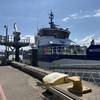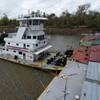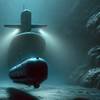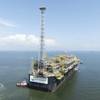Bollinger Builds Diverse Portfolio
Another example of Bollinger Shipyards' ability and willingness to integrate customer demand into its new products is the new Super Shelf Boat, Ms. Sara Jane. When MNM Boats, the operating division of C&G Boats, was shopping for its new vessel, it talked to many drillers and oil companies, discovering that the ability to hold large volumes of liquid mud - oftentimes two or more different weights without cross contamination - would be crucial to finding employment for vessels in the future. The reason: companies drilling on the shelf are now increasingly going deeper … to 25,000 feet … to hit oil, and more mud is needed per well.
At the same time Bollinger's engineering and sales staff were talking to their customers about a larger vessel following on to its successful 145-ft. utility/supply boat.design. As luck may have it, a subsequent cross with C&G produced the revelation that both companies were on the same track.
What evolved was a 207- x 53- x 19-ft. vessel with six liquid mud tanks with a total capacity of 6,241 barrels. Bollinger designed three separate pumping and piping systems so three types of mud could be offloaded without contamination. The liquid mud tanks are located port and starboard with five spherical bulk mud tanks separating them along the keel of the boat. The bulk mud tanks hold 6,000 cu. ft. of dry bulk material and feature two separate piping and pumping systems enabling the vessel to carry and offload two types of dry bulk product.
The new vessels have installed an IVCS 2000 supplied by Beier Radio, a system rated DP-1 by ABS. Bollinger chose Caterpillar diesel engines (Model 3515B, 2,000 hp each at 1,600 rpm) supplied by Louisiana Machinery. Bollinger built the 102-in. stainless steel propellers and shafts.
L/B Myrtle
L/B Myrtle is a Darwin-esque step forward in liftboat technology. What makes L/B Myrtle different from others in the category is that it is equipped with a bow thruster and controllable pitch (CP) propellers for greater maneuverability and pinpoint positioning of the huge legs with oversized pads on the ocean bottom. Built for Montco Offshore, Inc. of Golden Meadow, La., the 137.5-foot liftboat is equipped with 245-ft. legs, enabling the self-propelled floating platform to work in water depths to 180 ft. with a 15-ft. air gap while lifting a total of 850 KIPS of variable load.
"The bow thruster, CP wheels and joystick operations give us the edge," said Lee Orgeron, Montco's president. "With this high degree of control over the boat, we can more effectively avoid contact with underwater piping, can-holes, and other rig infrastructure."
The technology comes with a price, but one that Montco believes is justified in the extras it can offer its customers. "This extra equipment is very expensive. We put it on the L/B Myrtle to help our customers improve their bottom line, while it helps us to have satisfied customers." Orgeron said that almost all liftboats use their main engines to either maneuver or operate the leg lift system while in neutral, which interferes with positioning. "With this boat, we can maintain jacking speed and maneuvering and hold a precise position at the same time."
The vessel, named in honor of Myrtle Orgeron, mother of Lee Orgeron, is equipped with 40 by 16-ft. pads, much larger than those on other liftboats, to provide for greater bottom stability and greater deck loads. The L/B Myrtle can also jack with a full pre-load and its pre-load system has quick acting stainless steel dump valves.
It is equipped with three Nautilus cranes with 150, 50 and 25-ton capacities in an innovative configuration. The smaller crane is positioned on the starboard stern so that support vessels can tie-up to the liftboat and offload personnel, cargo, and/or fluids without hindering other work being done by the liftboat. The 150-ton crane has a 110-ft. boom and is equipped with VHF radio, loudhailer, load indicator and boom-mounted video camera with monitor to assist when load hook-ups are out of the normal view of the operator. "That is another indicator of the work we and Bollinger did to design the most efficient liftboat possible," said Orgeron.
The boat has a 92-ft. beam and hull depth of 13-ft. Open deck area is 6,000 sq. ft. feet. Its three 72-in. diameter legs are constructed of 1.5-in. wall thickness high strength steel, and operate via a Hydraquip jacking system. Power is supplied by two Caterpillar 3512 diesels developing a total of 3,000 bhp. They drive Berg controllable pitch propellers through Reintjes reduction gears. Electrical power is produced by two 190 kW generators driven by Caterpillar 3306 diesels. A 350 bhp hydraulic motor drives the bow thruster. Regulatory classifications are ABS loadline, SOLAS/MARPOL, USCG Subchapter L.
Some capacities are: 27,880 gallons fuel; 14,875 gallons fresh water; 250 gallons lube oil; 1,000 gallons hydraulic oil; 250 gallons crane hydraulic oil; 250 gallons dirty oil; 250 gallons oily bilge water, and 13,500 gallons zero discharge tank.














